The Sustainability Study and Exploration in the Building Commercial Complex System Based on Life Cycle Assessment (LCA)–Emergy–Carbon Emission Analysis
Abstract
:1. Introduction
2. Material and Methods
2.1. Research Framework
2.2. Emergy Diagram of the Building System
2.3. LCA-Emergy Analysis Model
2.4. Emergy Indexes
2.5. LCA-Carbon Emission Calculation Model
3. Case Study and Data Collection
3.1. Case Introduction
- (1)
- Optimizing orientation and layout: Maximizing the use of daylighting and natural ventilation by strategically positioning and designing buildings to reduce energy consumption.
- (2)
- High-performance insulation materials: Utilizing high-quality insulation materials such as insulation materials and double-glazed windows to minimize heat transfer and energy loss.
- (3)
- Natural lighting and lighting control: Designing windows and skylights effectively to increase natural lighting and implementing intelligent lighting systems to reduce energy consumption.
- (4)
- Thermal bridge control: Designing to avoid or minimize thermal bridges, which prevent heat from transferring through the building structure and improve thermal performance.
- (5)
- Natural ventilation: Designing appropriate ventilation systems to utilize natural airflow for air circulation and improvement of indoor air quality, reducing reliance on mechanical ventilation.
- (6)
- Passive solar energy utilization: Maximizing the use of solar energy to meet the building’s energy needs through the selection of suitable materials and design features such as solar collectors and photovoltaic panels.
- (7)
- Green roofs and vertical greening: Adding vegetation layers such as green roofs and vertical green walls to provide insulation and thermal benefits, enhancing indoor comfort.
- (8)
- Optimization of heating, cooling, and ventilation systems: Designing efficient systems like geothermal energy and air-source heat pumps to reduce energy consumption and carbon emissions.
3.2. Data Collection
4. Results and Discussion
4.1. LCA-Emergy Analysis
4.1.1. Primary Emergy Contributors Analysis
4.1.2. Sustainable Indicator Analysis
4.1.3. Sensitivity Analysis
4.2. LCA-Carbon Emission Analysis
4.2.1. The Carbon Emission of the Building Material Production and Transport Stages
4.2.2. The Carbon Emission of Building Construction Stage
4.2.3. The Carbon Emission in the Building Operation Stage
4.2.4. The Carbon Emission in the Building Demolition Stage
4.2.5. Life Cycle Carbon Emission Status
4.3. Entropy Analysis of Building System
5. Improvement Measures and Strategies
5.1. Renewable Energy Use
5.2. Carbon Sink Improvement
- ➢
- The two carbon absorption models are calculated as follows:
- ➢
- The two kinds of carbon absorption effects are verified as follows:
6. Conclusions
- (1)
- The results highlight that the building operation stage plays a critical role, accounting for roughly 45% of the entire emergy in the building complex. Additionally, the carbon emission amount in the building operation stage accounts for the majority, approximately 97.4% of the entire carbon dioxide proportion. These two analyses indicate that the ecology and carbon emission of the building operation phase needs to be focused on.
- (2)
- According to the Renewable rate (Ri) and Non-renewable rate (Ni), Emergy yield ratio (EYR), Environmental loading ratio (ELR), and Emergy sustainability indicator (ESI) were counted, which are 26.3, 74.2, 0.354, respectively. Taking the ESI as an example, its eligibility criteria are 1. Now the result is 0.354 (less than 1), illustrating that the sustainability of the building system is not qualified and needs to enhance sustainability degree.
- (3)
- The carbon emission amount in the building operation stage accounts for the majority, approximately 97.4% of the entire carbon dioxide proportion. This highlights that the operational phase of the building system emits a significant amount of carbon dioxide within the 50-year cycle range, requiring special attention to reduce system carbon emissions and improve the sustainability of the entire building system.
- (4)
- Two optimized measures were provided, involving renewable energy use and carbon sink improvement, respectively. Simultaneously, both types of effects have also been validated.
Author Contributions
Funding
Institutional Review Board Statement
Informed Consent Statement
Data Availability Statement
Conflicts of Interest
References
- Goubran, S.; Walker, T.; Cucuzzella, C.; Schwartz, T. Green building standards and the United Nations’ Sustainable Development Goals. J. Environ. Manag. 2023, 326, 116552. [Google Scholar] [CrossRef] [PubMed]
- Guidetti, E.; Ferrara, M. Embodied energy in existing buildings as a tool for sustainable intervention on urban heritage. Sustain. Cities Soc. 2023, 88, 104284. [Google Scholar] [CrossRef]
- Tang, Z.W.; Ng, T.S.; Skitmore, M. Influence of procurement systems to the success of sustainable buildings. J. Clean. Prod. 2019, 218, 1007–1030. [Google Scholar] [CrossRef]
- Shukla, A.K.; Sudhakar, K.; Baredar, P.; Mamat, R. BIPV based sustainable building in South Asian countries. Sol. Energy 2018, 170, 1162–1170. [Google Scholar] [CrossRef]
- Tsinghua University Building Energy Saving Research Center. 2019 Annual Report on China Building Energy Efficiency; China Architecture and Building Press: Beijing, China, 2019. (In Chinese) [Google Scholar]
- China Construction Industry Association. Construction Industry Development Statistical Analysis Report; China Construction Industry Association: Beijing, China, 2022. [Google Scholar]
- Chen, R.; Tsay, Y.-S.; Zhang, T. A multi-objective optimization strategy for building carbon emission from the whole life cycle perspective. Energy 2023, 262, 125373. [Google Scholar] [CrossRef]
- Du, Q.; Wang, Y.; Pang, Q.; Hao, T.; Zhou, Y. The dynamic analysis on low-carbon building adoption under emission trading scheme. Energy 2023, 263, 125946. [Google Scholar] [CrossRef]
- Zhang, J.; Ma, L. Urban ecological security dynamic analysis based on an innovative emergy ecological footprint method. Environ. Dev. Sustain. 2021, 23, 16163–16191. [Google Scholar] [CrossRef]
- Fischer, H.; Frühwald, F.; Korjenic, A. Ecological comparison of hygrothermally safe floor constructions based on renewable raw materials for multi-storey buildings. J. Build. Eng. 2022, 57, 104899. [Google Scholar] [CrossRef]
- Fan, X.; Rong, Y.; Tian, C.; Ou, S.; Li, J.; Shi, H.; Qin, Y.; He, J.; Huang, C. Construction of an Ecological Security Pattern in an Urban-Lake Symbiosis Area: A Case Study of Hefei Metropolitan Area. Remote Sens. 2022, 14, 2498. [Google Scholar] [CrossRef]
- D’Ambrosio, V.; Di Martino, F.; Rigillo, M. GIS-Based Model for Constructing Ecological Efficiency Maps of Urban Green Areas: The Case Study of Western Naples, Italy. Sustainability 2022, 14, 6830. [Google Scholar] [CrossRef]
- Chen, X.; Wang, H.; Zhang, J.; Zhang, H.; Asutosh, A.T.; Wu, G.; Wei, G.; Shi, Y.; Yang, M. Sustainability Study of a Residential Building near Subway Based on LCA-Emergy Method. Buildings 2022, 12, 679. [Google Scholar] [CrossRef]
- Brian, F.A.; Guo, H.W. Stakeholders’ perspectives on BIM and LCA for green buildings. J. Build. Eng. 2022, 48, 103931. [Google Scholar]
- Anand, C.K.; Amor, B. Recent developments, future challenges and new research directions in LCA of buildings: A critical review. Renew. Sustain. Energy Rev. 2017, 67, 408–416. [Google Scholar] [CrossRef]
- Villa, V.; Bruno, G.; Aliev, K.; Piantanida, P.; Corneli, A.; Antonelli, D. Machine Learning Framework for the Sustainable Maintenance of Building Facilities. Sustainability 2022, 14, 681. [Google Scholar] [CrossRef]
- Wang, W. Automatic System Design of Assembly Building Components for Sustainable Building Projects Based on BIM Technology. Math. Probl. Eng. 2022, 11, 4902862. [Google Scholar] [CrossRef]
- Bahadiroğlu, A.; Koç, A.Y.; Parlak, E.; Larsson, N.; Kujawski, W.; Unver, U. Sustainable building evaluation: A case study, Energy Sources Part A Recovery Util . Environ. Eff. 2022, 44, 3149–3163. [Google Scholar]
- Assefa, S.; Lee, H.-Y.; Shiue, F.-J. A building sustainability assessment system (BSAS) for least developed countries: A case of Ethiopia. Sustain. Cities Soc. 2022, 87, 104238. [Google Scholar] [CrossRef]
- Wang, Y.; Chen, D.; Tian, P. Research on the Impact Path of the Sustainable Development of Green Buildings: Evidence from China. Sustainability 2022, 14, 13628. [Google Scholar] [CrossRef]
- Scherz, M.; Hoxha, E.; Kreiner, H.; Passer, A.; Vafadarnikjoo, A. A hierarchical reference-based know-why model for design support of sustainable building envelopes. Autom. Constr. 2022, 139, 104276. [Google Scholar] [CrossRef]
- Zhang, J.; Zhang, H.; Asutosh, A.T.; Sun, N.; Fu, X.; Wang, H.; Li, X. Ecological sustainability assessment of building glass industry in China based on the point of view of raw material emergy and chemical composition. Environ. Sci. Pollut. Res. 2023, 30, 40670–40697. [Google Scholar] [CrossRef]
- Zhang, J.; Srinivasan, R.S.; Peng, C. A Systematic Approach to Calculate Unit Emergy Values of Cement Manufacturing in China Using Consumption Quota of Dry and Wet Raw Materials. Buildings 2020, 10, 128. [Google Scholar] [CrossRef]
- Zhang, J.; Srinivasan, R.S.; Peng, C. Ecological Assessment of Clay Brick Manufacturing in China Using Emergy Analysis. Buildings 2020, 10, 190. [Google Scholar] [CrossRef]
- Thomas, T.; Praveen, A. Emergy parameters for ensuring sustainable use of building materials. J. Clean. Prod. 2020, 276, 122382. [Google Scholar] [CrossRef]
- Amponsah, N.; Lacarrière, B.; Jamali-Zghal, N.; Le Corre, O. Impact of building material recycle or reuse on selected emergy ratios. Resour. Conserv. Recycl. 2012, 67, 9–17. [Google Scholar] [CrossRef] [Green Version]
- Pulselli, R.M.; Simoncini, E.; Ridolfi, R.; Bastianoni, S. Specifific emergy of cement and concrete: An energy-based appraisal of building materials and their transport. Ecol. Indic. 2008, 8, 647–656. [Google Scholar] [CrossRef]
- Yi, H.; Braham, W.W.; Tilley, D.R.; Srinivasan, R. A metabolic network approach to building performance: Information building modeling and simulation of biological indicators. J. Clean. Prod. 2017, 165, 1133–1162. [Google Scholar] [CrossRef]
- Paneru, S.; Foroutan Jahromi, F.; Hatami, M.; Roudebush, W.; Jeelani, I. Integration of Emergy. Analysis with Building Information Modeling. Sustainability 2021, 13, 7990. [Google Scholar] [CrossRef]
- Wang, J.; Wang, J.; Yang, X.; Xie, K.; Wang, D. A novel emergy-based optimization model of a building cooling, heating and power system. Energy Convers. Manag. 2022, 268, 115987. [Google Scholar] [CrossRef]
- Kumar, T.; Srinivasan, R.; Mani, M. An Emergy-based Approach to Evaluate the Effectiveness of Integrating IoT-based Sensing Systems into Smart Buildings. Sustain. Energy Technol. Assess. 2022, 52, 102225. [Google Scholar] [CrossRef]
- Wang, J.; Xu, S.; Ma, G.; Gou, Q.; Zhao, P.; Jia, X. Emergy analysis and optimization for a solar-driven heating and cooling system integrated with air source heat pump in the ultra-low energy building. J. Build. Eng. 2023, 63, 105467. [Google Scholar] [CrossRef]
- Pulselli, R.; Mazzali, U.; Peron, F.; Bastianoni, S. Emergy based evaluation of environmental performances of Living Wall and Grass Wall systems. Energy Build. 2014, 73, 200–211. [Google Scholar] [CrossRef]
- Luo, Z.; Zhao, J.; Yao, R.; Shu, Z. Emergy-based sustainability assessment of different energy options for green buildings. Energy Convers. Manag. 2015, 100, 97–102. [Google Scholar] [CrossRef]
- Huang, P.-J.; Huang, S.-L.; Marcotullio, P.J. Relationships between CO2 emissions and embodied energy in building construction: A historical analysis of Taipei. Build. Environ. 2019, 155, 360–375. [Google Scholar] [CrossRef]
- Li, D.; Zhu, J.; Hui, E.C.; Leung, B.Y.; Li, Q. An emergy analysis-based methodology for eco-effificiency evaluation of building manufacturing. Ecol. Indic. 2011, 11, 1419–1425. [Google Scholar] [CrossRef]
- Andrić, I.; Pina, A.; Ferrão, P.; Lacarrière, B.; Le Corre, O. The impact of renovation measures on building environmental performance: An emergy approach. J. Clean. Prod. 2017, 162, 776–790. [Google Scholar] [CrossRef]
- Lee, J.M.; Braham, W.W. Building emergy analysis of Manhattan: Density parameters for high-density and high-rise developments. Ecol. Model. 2017, 363, 157–171. [Google Scholar] [CrossRef]
- Srinivasan, R.S.; Braham, W.W.; Campbell, D.E.; Curcija, C.D. Re(De)fifining Net Zero Energy: Renewable Emergy Balance in environmental building design. Build. Environ. 2012, 47, 300–315. [Google Scholar] [CrossRef]
- Rothrock, H. Sustainable housing: Emergy evaluation of an off-grid residence. Energy Build. 2014, 85, 287–292. [Google Scholar] [CrossRef]
- Yi, H.; Braham, W.W. Uncertainty characterization of building emergy analysis (BEmA). Build. Environ. 2015, 92, 538–558. [Google Scholar] [CrossRef]
- Zhu, C.; Li, X.; Zhu, W.; Gong, W. Embodied carbon emissions and mitigation potential in China’s building sector: An outlook to 2060. Energy Policy 2022, 170, 113222. [Google Scholar] [CrossRef]
- Hiyama, K.; Srisamranrungruang, T. Low-carbon assessment of building facades using dynamic CO2 intensity of electricity generation in Japan. Energy Build. 2023, 278, 112637. [Google Scholar] [CrossRef]
- Liu, J.; Bao, L.; Ye, B.; Wang, J. Low-carbon progressive design for sustainable development of buildings. Indoor Built Environ. 2023, 0, 1–19. [Google Scholar] [CrossRef]
- Ansah, M.K.; Chen, X.; Yang, H. A holistic environmental and economic design optimization of low carbon buildings considering climate change and confounding factors. Sci. Total Environ. 2022, 821, 153442. [Google Scholar] [CrossRef] [PubMed]
- Li, Y.; Li, S.; Xia, S.; Li, B.; Zhang, X.; Wang, B.; Ye, T.; Zheng, W. A Review on the Policy, Technology and Evaluation Method of Low-Carbon Buildings and Communities. Energies 2023, 16, 1773. [Google Scholar] [CrossRef]
- Nie, S.; Zhou, J.; Yang, F.; Lan, M.; Li, J.; Zhang, Z.; Chen, Z.; Xu, M.; Li, H.; Sanjayan, J.G. Sanjayan. Analysis of theoretical carbon dioxide emissions from cement production: Methodology and application. J. Clean. Prod. 2022, 334, 130270. [Google Scholar] [CrossRef]
- Xing, X.; Ye, A. Consumption Upgrading and Industrial Structural Change: A General Equilibrium Analysis and Empirical Test with Low-Carbon Green Transition Constraints. Sustainability 2022, 14, 13645. [Google Scholar] [CrossRef]
- Xu, C.; Gong, Y.; Yan, G. Research on Cement Demand Forecast and Low Carbon Development Strategy in Shandong Province. Atmosphere 2023, 14, 267. [Google Scholar] [CrossRef]
- Wang, X.; Du, Q.; Lu, C.; Li, J. Exploration in carbon emission reduction effect of low-carbon practices in prefabricated building supply chain. J. Clean. Prod. 2022, 368, 133153. [Google Scholar] [CrossRef]
- Fan, M.; Gu, Z.; Li, W.; Zhou, D.; Yu, C.W. Integration of a large green corridor with an underground complex—A low carbon building solution for urban climate revival. Indoor Built Environ. 2022, 1, 872–877. [Google Scholar] [CrossRef]
- Zhang, Q.; Wu, X.; Chen, Y. Is economic crisis an opportunity for realizing the low-carbon transition? A simulation study on the interaction between economic cycle and energy regulation policy. Energy Policy 2022, 168, 113114. [Google Scholar] [CrossRef]
- Zhang, N.; Luo, Z.; Liu, Y.; Feng, W.; Zhou, N.; Yang, L. Towards low-carbon cities through building-stock-level carbon emission analysis: A calculating and mapping method. Sustain. Cities Soc. 2022, 78, 103633. [Google Scholar] [CrossRef]
- Liu, Y.; Xue, S.; Guo, X.; Zhang, B.; Sun, X.; Zhang, Q.; Wang, Y.; Dong, Y. Towards the goal of zero-carbon building retrofitting with variant application degrees of low-carbon technologies: Mitigation potential and cost-benefit analysis for a kindergarten in Beijing. J. Clean. Prod. 2023, 393, 136316. [Google Scholar] [CrossRef]
- Xie, F.; Zhang, J.; Wu, G.; Zhang, C.; Wang, H. The Environmental Sustainability Study of an Airport Building System Based on an Integrated LCA-Embodied Energy (Emergy)-ANN Analysis. Sustainability 2023, 15, 7626. [Google Scholar] [CrossRef]
- GB/T 51366-2019; Standard for Building Carbon Emission Calculation. Ministry of Housing and Urban-Rural Development of the People’s Republic of China: Beijing, China, 2019. Available online: http://www.ntgh.com.cn/News_Info.aspx?id=2367 (accessed on 5 June 2023).
- GB 55031-2022; General Code for Civil Buildings. Ministry of Housing and Urban-Rural Development of China: Beijing, China, 2022.
- Yin, Y.; Chen, H.; Zhao, X.; Yu, W.; Su, H.; Chen, Y.; Lin, P. Solar-absorbing energy storage materials demonstrating superior solar-thermal conversion and solar-persistent luminescence conversion towards building thermal management and passive illumination. Energy Convers. Manag. 2022, 266, 115804. [Google Scholar] [CrossRef]
- Mahaya, C.; Zemmouri, N.; Benharra, H.; Elnokaly, A. Solar Access Assessment in Semi-Arid Urban Context: An Application Study for Ten Urban Forms of Existing Apartment Buildings Districts in Batna City, Algeria. Sustain. Cities Soc. 2022, 83, 103909. [Google Scholar] [CrossRef]
- Xu, Q.; Dong, Y.-X.; Yang, R. Influence of the geographic proximity of city features on the spatial variation of urban carbon sinks: A case study on the Pearl River Delta. Environ. Pollut. 2018, 243, 354–363. [Google Scholar] [CrossRef]
- He, Y.; Ren, Y. Can carbon sink insurance and financial subsidies improve the carbon sequestration capacity of forestry? J. Clean. Prod. 2023, 397, 136618. [Google Scholar] [CrossRef]
- Pittau, F.; Lumia, G.; Heeren, N.; Iannaccone, G.; Habert, G. Retrofit as a carbon sink: The carbon storage potentials of the EU housing stock. J. Clean. Prod. 2019, 214, 365–376. [Google Scholar] [CrossRef]

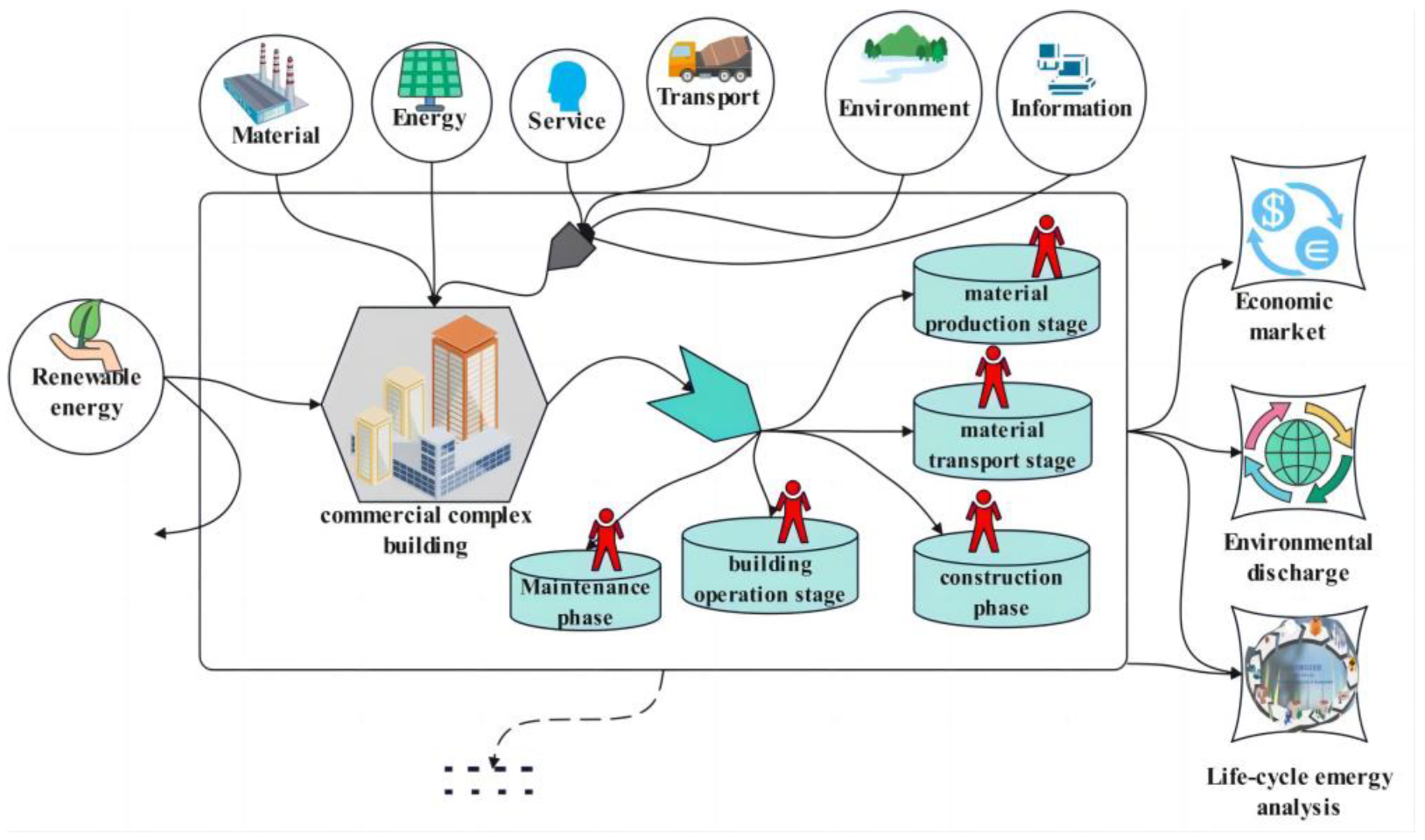
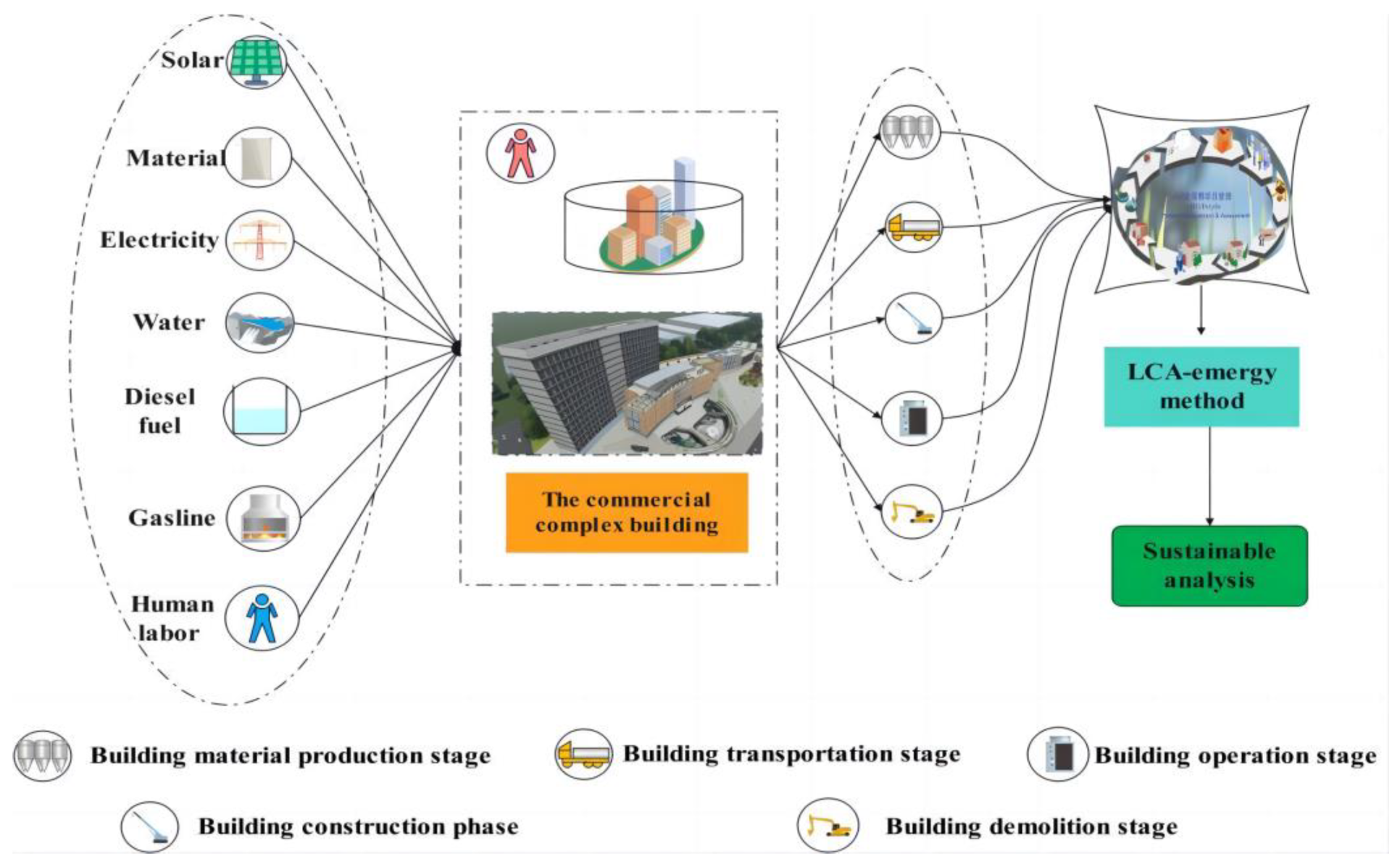



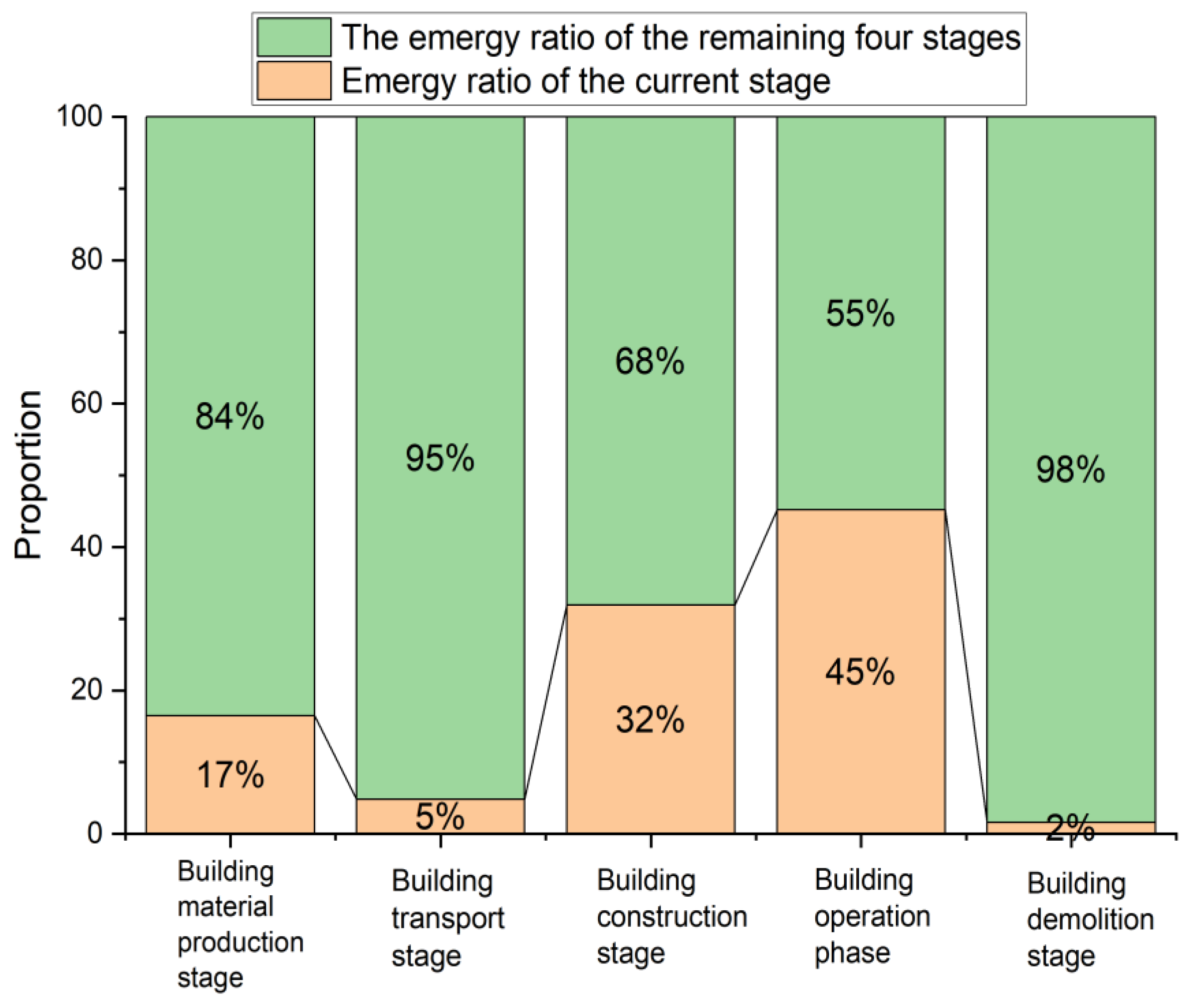



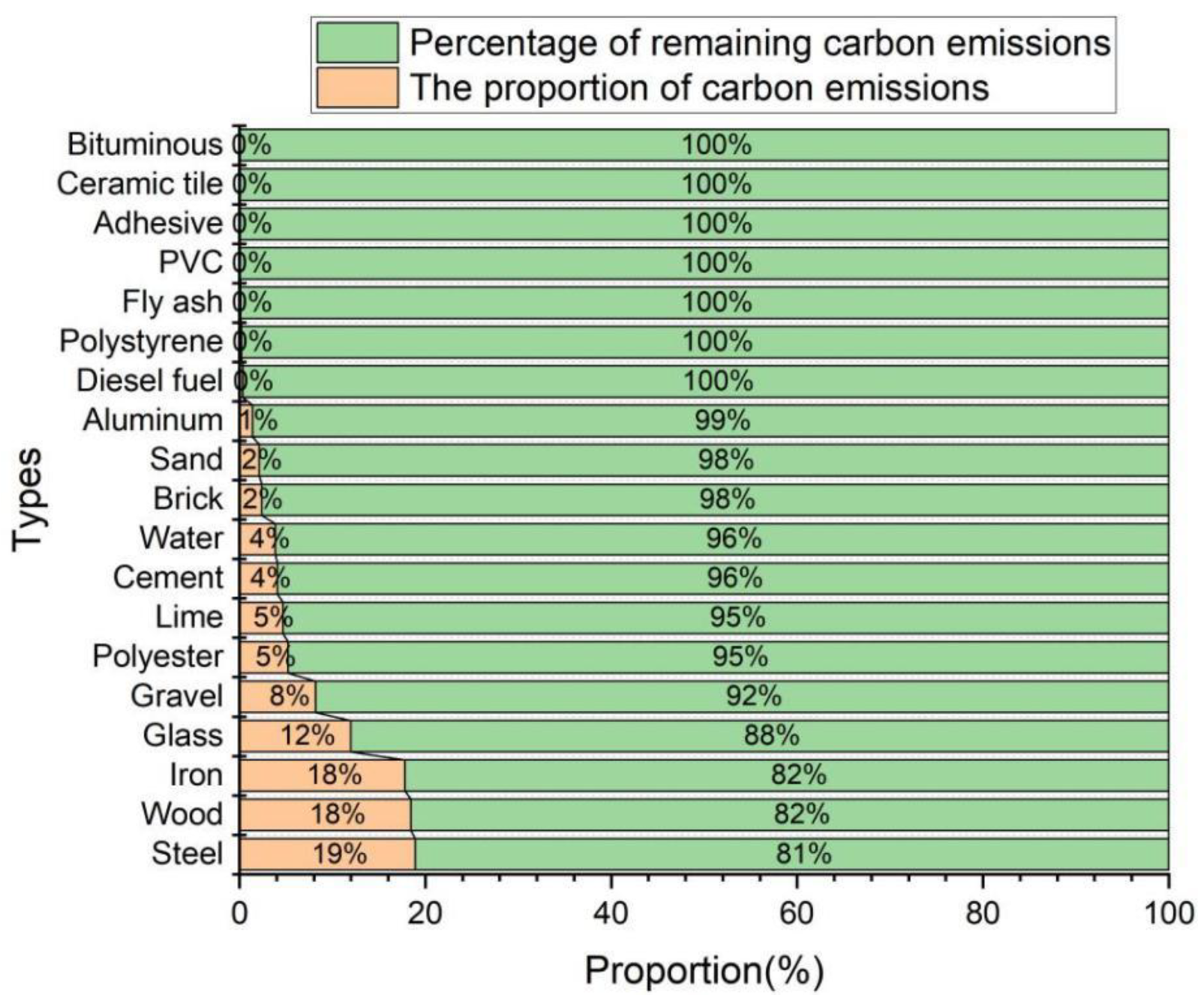

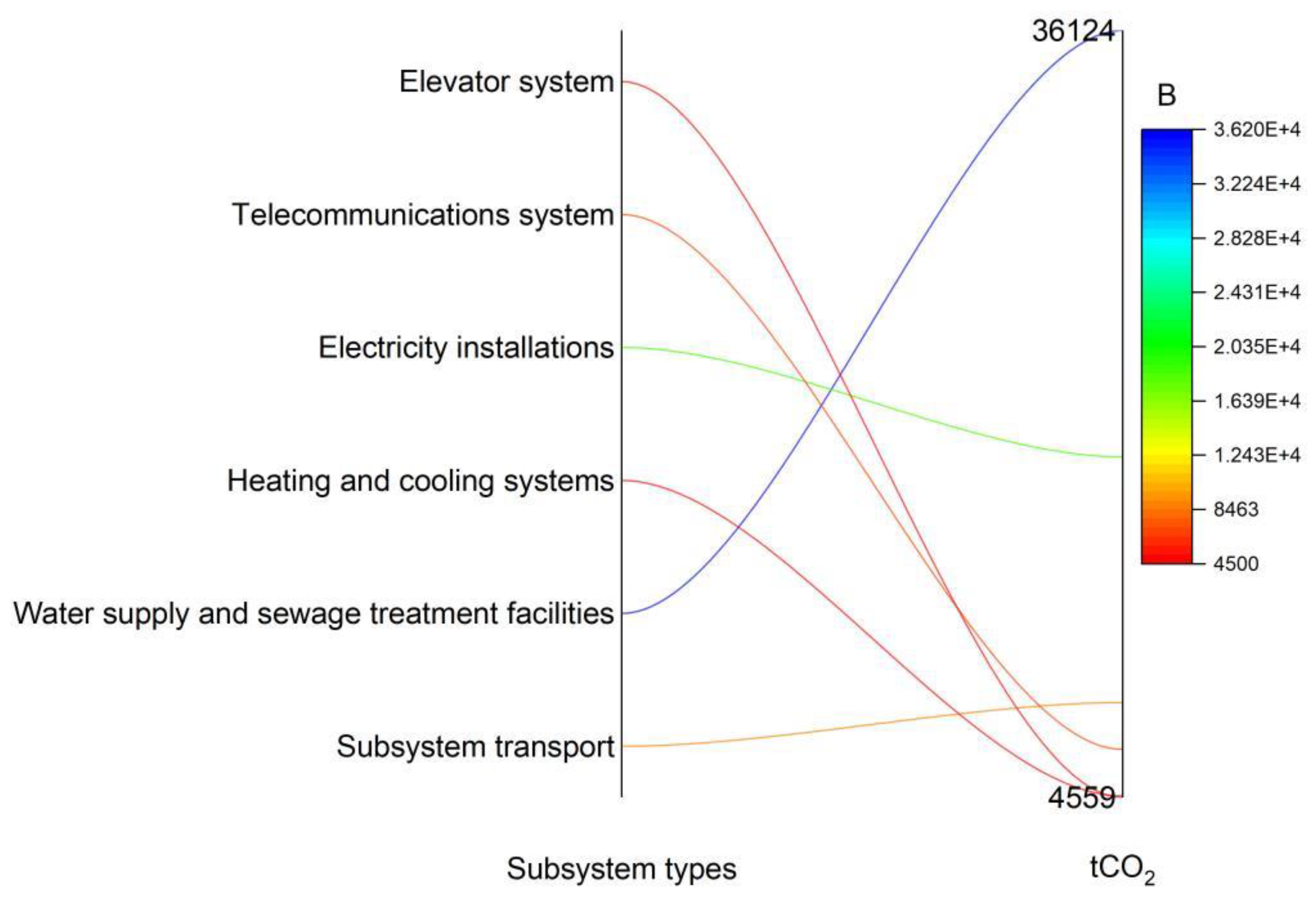
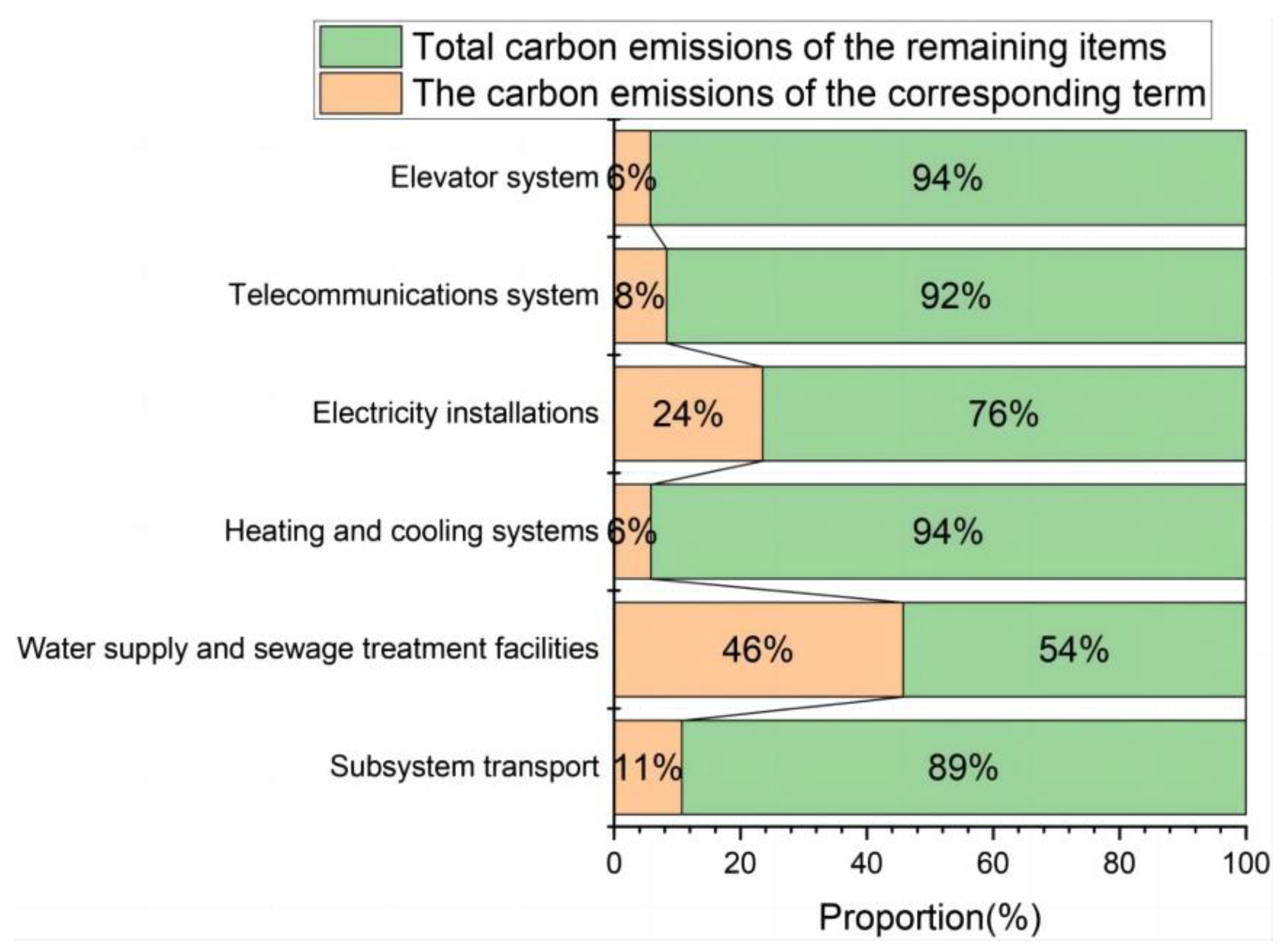
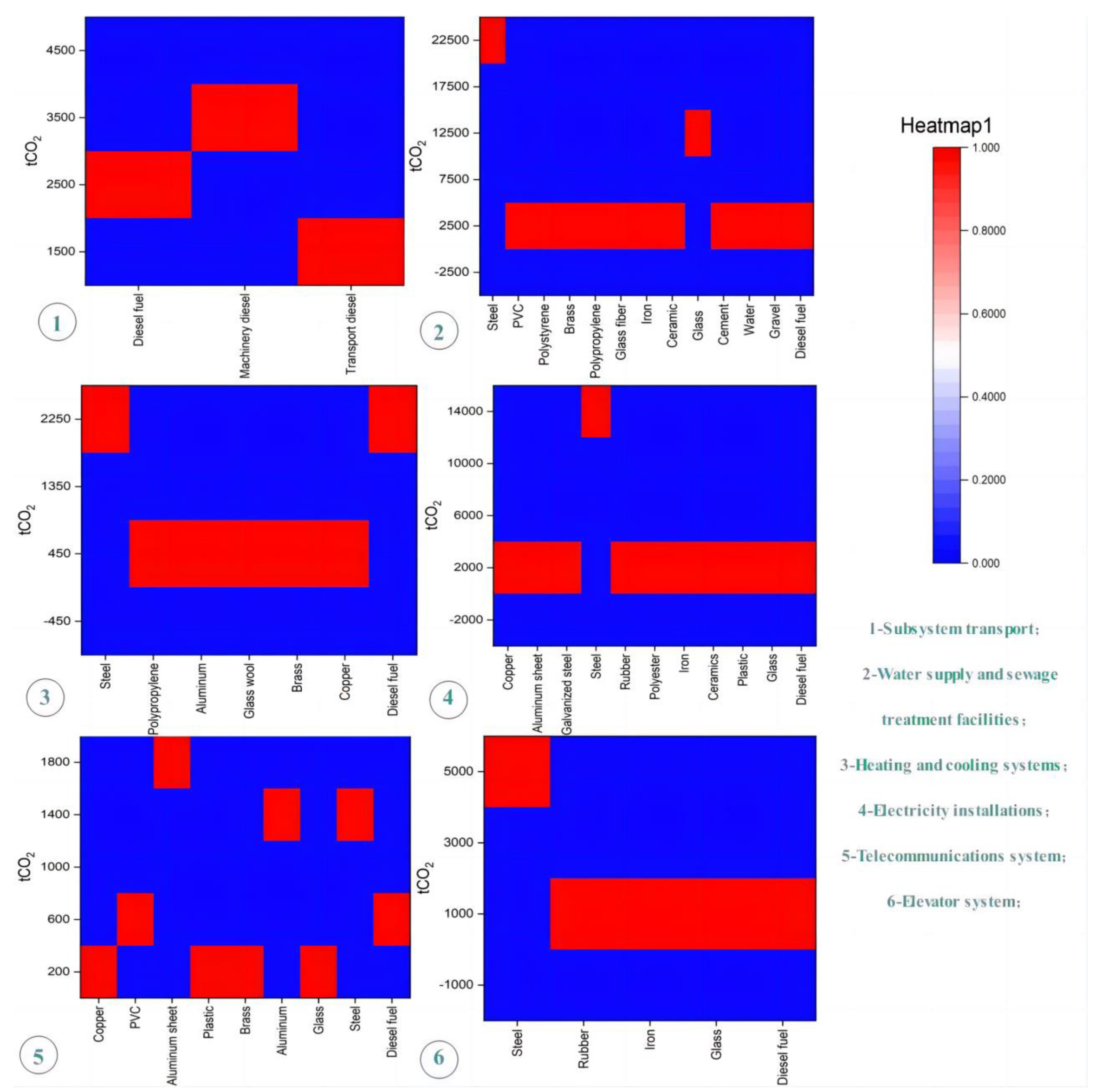



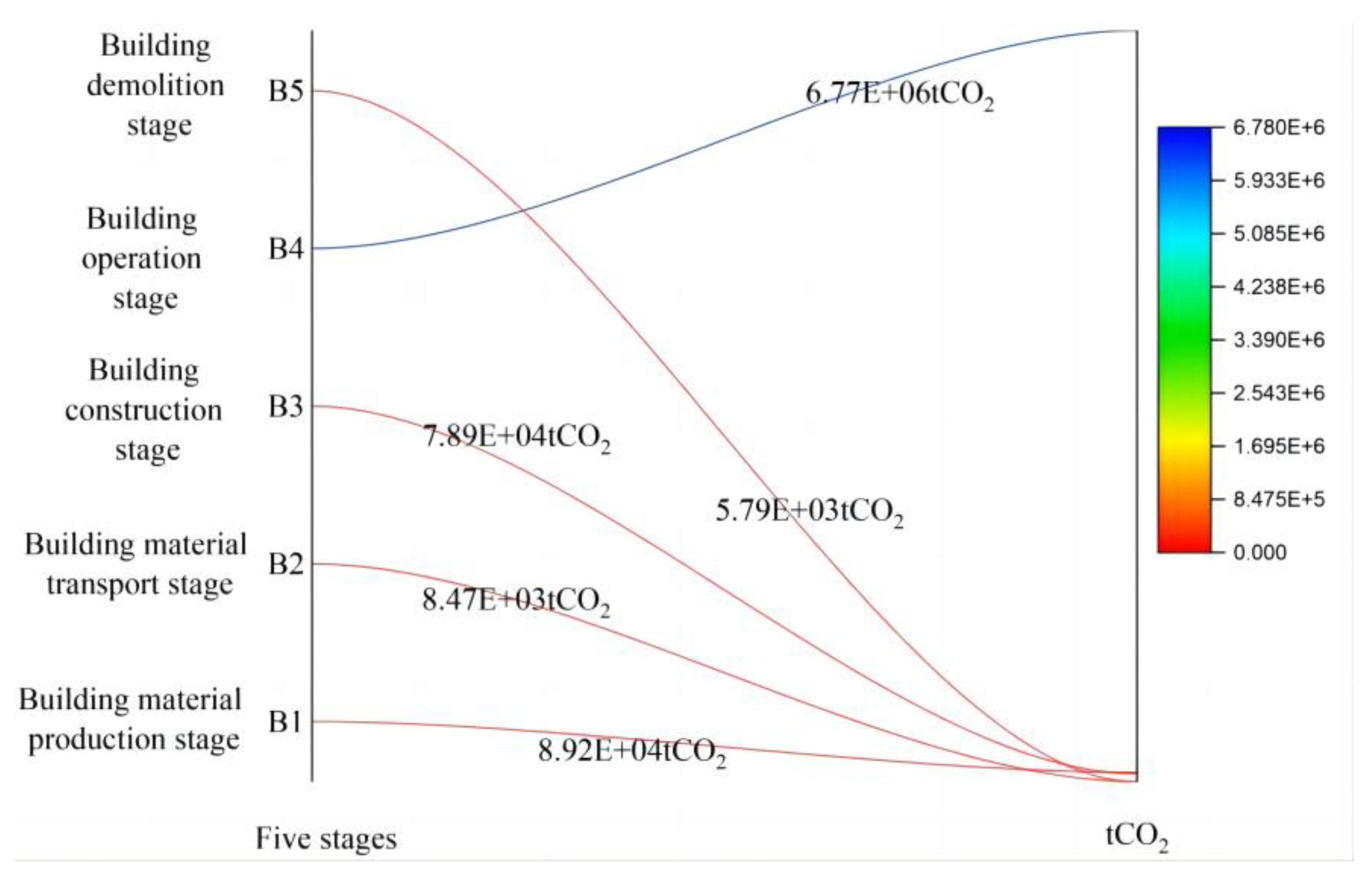


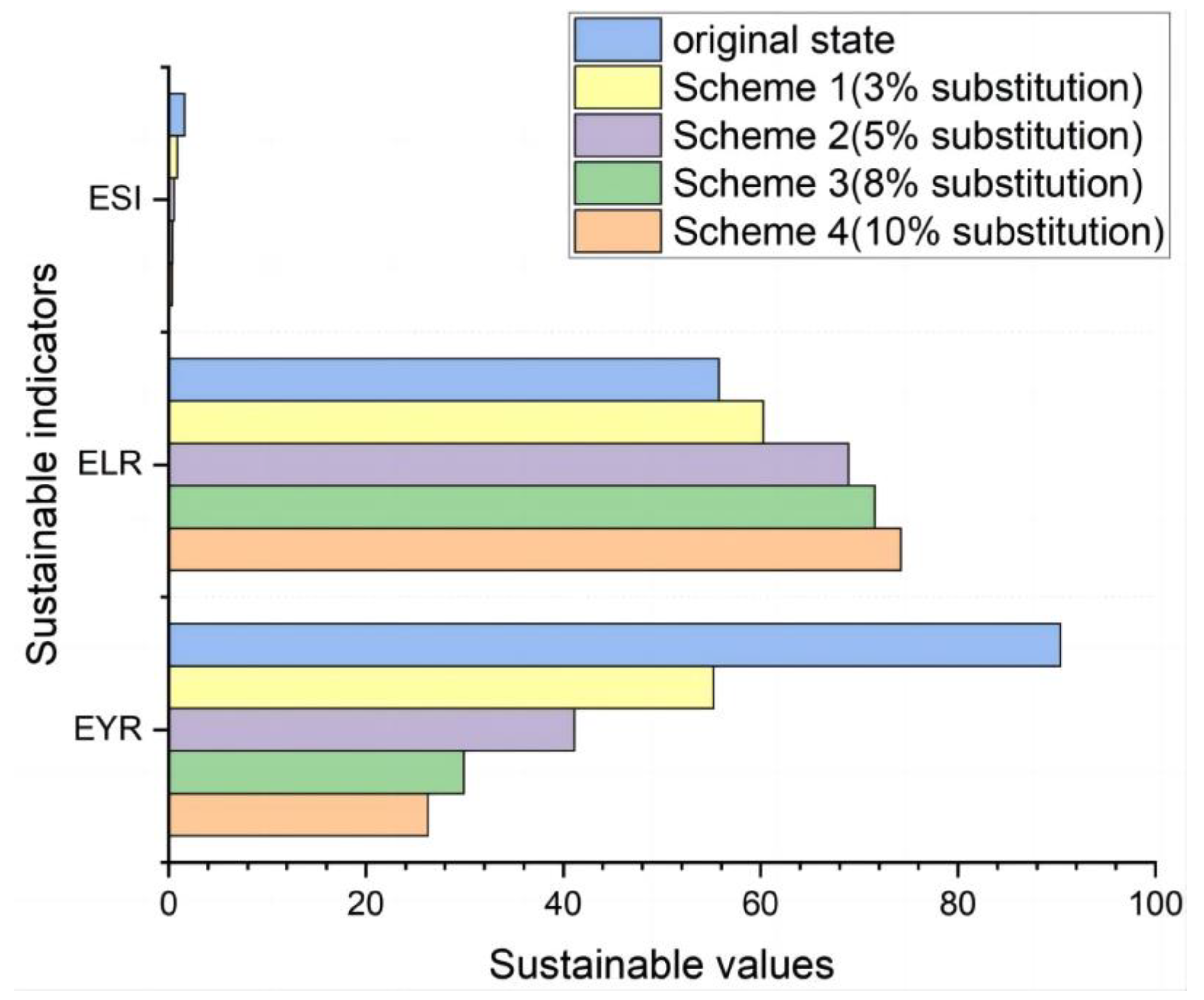
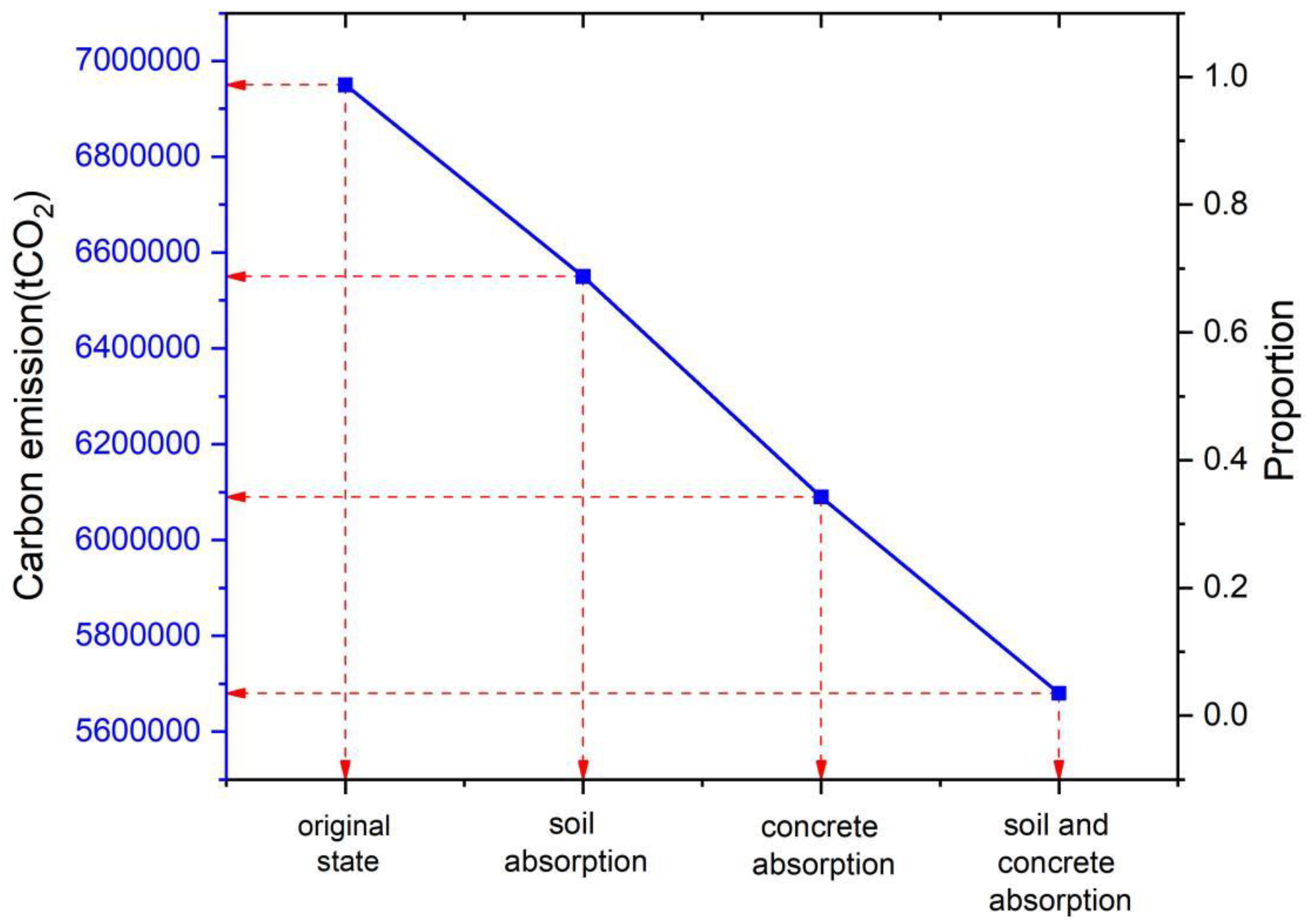
| Types | Equation | Explains |
|---|---|---|
| Solar | Where represents the solar emergy in the construction process; A is the site surface; J is the solar radiation amount (3.5 × 109 J/m2); is the surface albedo (0.7); is the construction time; is the unit emergy value. | |
| Material | Where is the emergy value of mass; is mass amount; represents the unit emergy value. | |
| Electricity | Where is the emergy of electricity in the building system. is the electricity quantity. is the unit emergy value of electricity. | |
| Water | Where is the water emergy; is the water volume; is the water density; G is the Gibbs energy of water (4.92 J/g); is the water transformity. | |
| Diesel fuel | Where is the emergy of the diesel fuel; is the amount of diesel oil used in the buildings system; is the calorific value of diesel fuel; is the unit emergy value of diesel fuel. | |
| Gasoline | Where is the gasoline emergy; is the gasoline quantity; is the calorific value of gasoline; is the unit emergy value of gasoline. | |
| Human labor | Where is the emergy of human labor; is the working time (8 h); is the number of employed workers; is the working day; is the unit emergy value of human labor. |
| Types | Equation | Explains |
|---|---|---|
| Total carbon emission | Where is the total carbon emission in the building system; is the carbon emission in the building material production stage; is the carbon emission in the construction material transport stage; is the carbon emission in the construction phase; is the carbon emission in the operational use and maintenance phase; is the carbon emission in the abandoned and dismantled stage. | |
| Building material production stage | Where is the carbon emission calculation of the building material production stage; n is the number of building materials; is the consumption of building material i; is the carbon emission factor in the initial state; is the carbon emission factor in the recycling state; is the rate of attrition; is the recovery utilization rate. | |
| Material transport stage | Where is the carbon emission calculation of the construction transport stage; n is the number of building materials; is the consumption of building material i; is the amount of energy used to transport materials (t/100 t·km); is the transportation distance of materials or equipment (km); is the carbon emission factor. | |
| Construction stage | Where is the carbon emission calculation of the building construction stage; n is the quantity of equipment; m is the number of energy types; is the Total number of machines; is the energy consumed by machinery; is the carbon emission factor. | |
| Operational use stage | Where is the carbon emission calculation of operational use stage; m is the total types of energy; n is the material renewal quantity; t is the life of the building (year); is the energy expended per hour; is the total number of equipment; is the average operating hours of the device; is the carbon emission factor of equipment; is the maintenance update consumption; is the annual renewal rate; is the carbon emission factor of alternate material. | |
| Building demolition stage | Where is the carbon emission at the stage of building demolition; is the carbon emission of mechanical equipment; is the carbon emission of waste transportation. |
| Item | Data | Unit | Carbon Emission Factors | Carbon Emission | Unit |
|---|---|---|---|---|---|
| Steel | 6.31 × 103 | t | 2.67 tCO2/t | 16,847.7 | tCO2 |
| Cement | 5.23 × 104 | t | 0.07 tCO2/t | 3661 | tCO2 |
| Gravel | 4.57 × 102 | t | 16 kgCO2/kg | 7312 | tCO2 |
| Brick | 8.92 × 103 | t | 0.24 kgCO2/kg | 2140.8 | tCO2 |
| Lime | 9.52 × 103 | t | 0.44 tCO2/t | 4188.8 | tCO2 |
| Sand | 7.59 × 105 | t | 2.51 kgCO2/t | 1905.09 | tCO2 |
| Water | 4.22 × 106 | m3 | 0.82 kgCO2/m3 | 3460.4 | tCO2 |
| Iron | 7.74 × 103 | t | 2.05 tCO2/t | 15,867 | tCO2 |
| Wood | 5.31 × 105 | t | 0.31 kgCO2/kg | 16,461 | tCO2 |
| Glass | 7.63 × 103 | t | 1.4 kgCO2/kg | 10,682 | tCO2 |
| Polyester | 6.42 × 101 | t | 72.65 tCO2/t | 4664.13 | tCO2 |
| Adhesive | 5.19 × 101 | t | 1.1 kgCO2/kg | 57.09 | tCO2 |
| Bituminous | 6.83 × 101 | t | 0.04 kgCO2/kg | 2.732 | tCO2 |
| Aluminum | 7.89 × 101 | t | 15.8 tCO2/t | 1246.62 | tCO2 |
| Ceramic tile | 5.28 × 101 | t | 0.74 tCO2/t | 39.072 | tCO2 |
| Polystyrene | 4.82 × 101 | t | 3.78 kgCO2/kg | 182.196 | tCO2 |
| Fly ash | 5.69 × 102 | t | 0.18 tCO2/t | 102.42 | tCO2 |
| PVC | 1.37 × 101 | t | 4.79 kgCO2/kg | 65.623 | tCO2 |
| Diesel fuel | 7.84 × 101 | t | 3.797 tCO2/t | 297.6848 | tCO2 |
| Item | Data | Unit | Carbon Emission Factors | Carbon Emission | Unit |
|---|---|---|---|---|---|
| Subsystem Transport | |||||
| Diesel fuel | 7.50 × 102 | t | 3.797 tCO2/t | 2847.75 | tCO2 |
| Machinery diesel | 1.05 × 103 | t | 3.797 tCO2/t | 3986.85 | tCO2 |
| Transport diesel | 4.31 × 102 | t | 3.797 tCO2/t | 1636.51 | tCO2 |
| Water supply and sewage treatment facilities | |||||
| Steel | 7.60 × 106 | Kg | 2.67 tCO2/t | 20,283.99 | tCO2 |
| PVC | 1.38 × 104 | Kg | 4.79 kgCO2/kg | 66.24 | tCO2 |
| Polystyrene | 6.43 × 103 | Kg | 3.78 kgCO2/kg | 21.67 | tCO2 |
| Brass | 4.93 × 103 | Kg | 3.73 tCO2/t | 18.40 | tCO2 |
| Polypropylene | 9.43 × 103 | Kg | 5.98 tCO2/t | 56.40 | tCO2 |
| Glass fiber | 7.55 × 103 | Kg | 1.4 kgCO2/kg | 10.57 | tCO2 |
| Iron | 5.64 × 104 | Kg | 2.05 tCO2/t | 115.69 | tCO2 |
| Ceramic | 7.62 × 105 | Kg | 0.74 tCO2/t | 563.88 | tCO2 |
| Glass | 9.11 × 106 | Kg | 1.4 kgCO2/kg | 12,754 | tCO2 |
| Cement | 3.99 × 106 | Kg | 0.07 tCO2/t | 279.3 | tCO2 |
| Water | 6.38 × 104 | m3 | 0.82 kgCO2/m3 | 52.316 | tCO2 |
| Gravel | 6.69 × 104 | Kg | 16 kgCO2/kg | 1070.4 | tCO2 |
| Diesel fuel | 7.61 × 102 | t | 3.797 tCO2/t | 831.54 | tCO2 |
| Heating and cooling systems | |||||
| Steel | 7.12 × 105 | Kg | 2.67 tCO2/t | 1901.04 | tCO2 |
| Polypropylene | 6.76 × 103 | Kg | 5.98 tCO2/t | 40.41882 | tCO2 |
| Aluminum | 7.31 × 103 | Kg | 15.8 tCO2/t | 115.498 | tCO2 |
| Glass wool | 1.04 × 104 | Kg | 1.4 kgCO2/kg | 14.5894 | tCO2 |
| Brass | 9.81 × 103 | Kg | 3.73 tCO2/t | 36.59876 | tCO2 |
| Copper | 9.12 × 103 | Kg | 3.73 tCO2/t | 34.02879 | tCO2 |
| Diesel fuel | 6.51 × 102 | t | 3.797 tCO2/t | 2471.847 | tCO2 |
| Electricity installations | |||||
| Copper | 1.77 × 104 | Kg | 3.73 tCO2/t | 49.982 | tCO2 |
| Aluminum sheet | 6.37 × 104 | Kg | 15.8 tCO2/t | 761.56 | tCO2 |
| Galvanized steel | 7.56 × 104 | Kg | 15.8 tCO2/t | 903.76 | tCO2 |
| Steel | 1.19 × 106 | Kg | 15.8 tCO2/t | 14,283.2 | tCO2 |
| Rubber | 9.24 × 104 | Kg | 2.4 tCO2/t | 167.76 | tCO2 |
| Polyester | 1.03 × 104 | Kg | 72.65 tCO2/t | 568.458 | tCO2 |
| Iron | 7.19 × 104 | Kg | 2.05 tCO2/t | 111.52 | tCO2 |
| Ceramics | 8.96 × 104 | Kg | 0.74 tCO2/t | 50.172 | tCO2 |
| Plastic | 1.31 × 105 | Kg | 7.83 kgCO2/kg | 778.302 | tCO2 |
| Glass | 5.05 × 104 | Kg | 1.4 kgCO2/kg | 53.48 | tCO2 |
| Diesel fuel | 2.23 × 102 | t | 3.797 tCO2/t | 847.97 | tCO2 |
| Telecommunications system | |||||
| Copper | 7.44 × 104 | Kg | 3.73 tCO2/t | 277.50 | tCO2 |
| PVC | 8.81 × 104 | Kg | 4.79 kgCO2/kg | 422.20 | tCO2 |
| Aluminum sheet | 1.05 × 105 | Kg | 15.8 tCO2/t | 1666.15 | tCO2 |
| Plastic | 3.08 × 104 | Kg | 7.83 kgCO2/kg | 241.09 | tCO2 |
| Brass | 5.99 × 104 | Kg | 3.73 tCO2/t | 223.29 | tCO2 |
| Aluminum | 8.91 × 104 | Kg | 15.8 tCO2/t | 1407.25 | tCO2 |
| Glass | 1.17 × 105 | Kg | 1.4 kgCO2/kg | 164.28 | tCO2 |
| Steel | 8.97 × 104 | Kg | 15.8 tCO2/t | 1417.69 | tCO2 |
| Diesel fuel | 2.51 × 100 | t | 3.797 tCO2/t | 721.43 | tCO2 |
| Elevator system | |||||
| Steel | 2.79 × 105 | Kg | 15.8 tCO2/t | 4405.47 | tCO2 |
| Rubber | 7.03 × 103 | Kg | 2.4 tCO2/t | 16.87 | tCO2 |
| Iron | 1.18 × 104 | Kg | 2.05 tCO2/t | 24.19 | tCO2 |
| Glass | 1.20 × 104 | Kg | 1.4 kgCO2/kg | 16.76 | tCO2 |
| Diesel fuel | 2.52 × 101 | t | 3.797 tCO2/t | 95.84 | tCO2 |
| Item | Data | Unit | Carbon Emission Factors | Carbon Emission | Unit |
|---|---|---|---|---|---|
| Electricity | 7.41 × 109 | kWh | 0.7025 kgCO2/kWh | 5.21 × 106 | tCO2 |
| Heat | 7.79 × 108 | J | 0.002 tCO2/J | 1.56 × 106 | tCO2 |
| Water | 8.25 × 106 | m3 | 0.82 kgCO2/m3 | 6.77 × 103 | tCO2 |
| Item | Data | Unit | Carbon Emission Factors | Carbon Emission | Unit |
|---|---|---|---|---|---|
| Glass | 1.17 × 106 | Kg | 1.4 kgCO2/kg | 1638 | tCO2 |
| Iron | 7.31 × 105 | Kg | 2.05 tCO2/t | 1498.6 | tCO2 |
| PVC | 3.19 × 104 | Kg | 4.79 kgCO2/kg | 152.8 | tCO2 |
| Aluminum | 6.48 × 104 | Kg | 15.8 tCO2/t | 1023.8 | tCO2 |
| Bricks | 6.61 × 105 | Kg | 0.24 kgCO2/kg | 158.6 | tCO2 |
| Concrete | 9.95 × 106 | Kg | 0.13 kgCO2/kg | 1293.5 | tCO2 |
| Diesel fuel | 7.83 × 103 | Kg | 3.797 tCO2/t | 29.73 | tCO2 |
| Stages | Abbreviation | Carbon Emission | Unit |
|---|---|---|---|
| Building material production stage | B1 | 8.92 × 104 | tCO2 |
| Building material transport stage | B2 | 8.47 × 103 | tCO2 |
| Building construction stage | B3 | 7.89 × 104 | tCO2 |
| Building operation stage | B4 | 6.77 × 106 | tCO2 |
| Building demolition stage | B5 | 5.79 × 103 | tCO2 |
Disclaimer/Publisher’s Note: The statements, opinions and data contained in all publications are solely those of the individual author(s) and contributor(s) and not of MDPI and/or the editor(s). MDPI and/or the editor(s) disclaim responsibility for any injury to people or property resulting from any ideas, methods, instructions or products referred to in the content. |
© 2023 by the authors. Licensee MDPI, Basel, Switzerland. This article is an open access article distributed under the terms and conditions of the Creative Commons Attribution (CC BY) license (https://creativecommons.org/licenses/by/4.0/).
Share and Cite
Cao, J.; Zhu, Y.; Zhang, J.; Wang, H.; Zhu, H. The Sustainability Study and Exploration in the Building Commercial Complex System Based on Life Cycle Assessment (LCA)–Emergy–Carbon Emission Analysis. Processes 2023, 11, 1989. https://doi.org/10.3390/pr11071989
Cao J, Zhu Y, Zhang J, Wang H, Zhu H. The Sustainability Study and Exploration in the Building Commercial Complex System Based on Life Cycle Assessment (LCA)–Emergy–Carbon Emission Analysis. Processes. 2023; 11(7):1989. https://doi.org/10.3390/pr11071989
Chicago/Turabian StyleCao, Jun, Yangfei Zhu, Junxue Zhang, Hechi Wang, and Haohao Zhu. 2023. "The Sustainability Study and Exploration in the Building Commercial Complex System Based on Life Cycle Assessment (LCA)–Emergy–Carbon Emission Analysis" Processes 11, no. 7: 1989. https://doi.org/10.3390/pr11071989
APA StyleCao, J., Zhu, Y., Zhang, J., Wang, H., & Zhu, H. (2023). The Sustainability Study and Exploration in the Building Commercial Complex System Based on Life Cycle Assessment (LCA)–Emergy–Carbon Emission Analysis. Processes, 11(7), 1989. https://doi.org/10.3390/pr11071989









